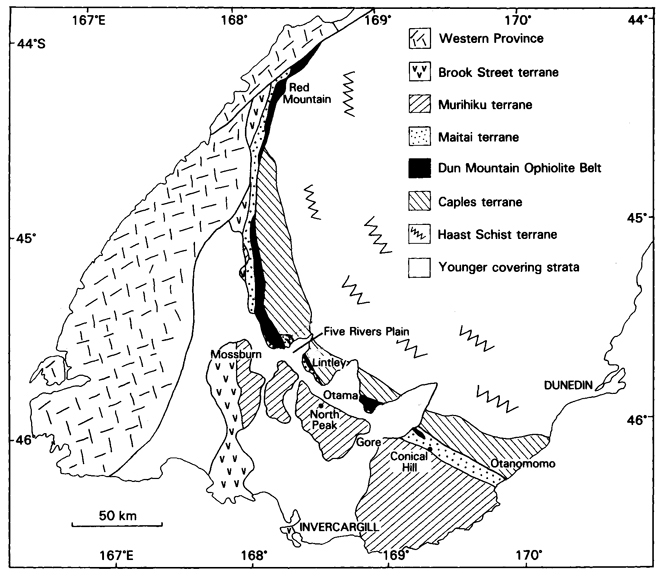Dunite (Dun Mountain)
Dunite was named by the German geologist, Ferdinand von Hochstetter in 1859 after Dun Mountain near Nelson, New Zealand. Dun Mountain was given its name because of the dun colour of the underlying ultramafic rocks. This color results from surface weathering that oxidizes the iron in olivine in temperate climates (weathering in tropical climates creates a deep red soil).A dunite is an ultrabasic igneous rock dominated by essential olivine (>90% volume), often with accessory clinopyroxene, orthopyroxene, spinel, ilmenite, and magnetite. Dunite is usually coarse- to medium grained and is a peridotite. Dunite forms either as a cumulate within layered intrusions or as a residue after extraction of partial melt from a pre-existing ultrabasic rock in the mantle. Dunite cumulates and mantle rocks are found as xenoliths in a wide range of mantle derived magmas.
Dunite and other peridotite rocks are considered the major constituents of the Earth's mantle above a depth of about 400 kilometers. Dunite is rarely found within continental rocks, but where it is found, it typically occurs at the base of ophiolite sequences where slabs of mantle rock from a subduction zone have been thrust onto continental crust by obduction during continental or island arc collisions (orogeny). It is also found in alpine peridotite massifs that represent slivers of sub-continental mantle exposed during collisional orogeny. Dunite typically undergoes retrograde metamorphism in near-surface environments and is altered to serpentinite and soapstone.
Dunite could be used to sequester CO2 and help mitigate global climate change via accelerated chemical rock weathering. This would involve the mining of dunite rocks in quarries followed by crushing and grinding as to create fine ground rock that would react with the atmospheric carbon dioxide. The resulting products are magnesite and silica which could be commercialized:
Mg2SiO4 (olivine) + 2CO2 = 2MgCO3 (magnesite) + SiO2 (silica)
Dun Mountain
Dun Mountain (Fig.1), rising to 1128m, is the highest mountain in the vicinity of Nelson City. The Dun ophiolite belt extend from an observed and inferred length of over 1100 Km. The mountain was named by early residents of Nelson for its dun colour. In 1859 the Austrian geologist Ferdinand von Hochstetter discovered that the mountain was made of dense igneous rock, composed chiefly of two minerals olivine and chromite. This unusual rock he named dunite, a name since applied to rocks of this type throughout the world. Because of the peculiar rock composition, the soils lack plant nutrients and so are devoid of vegetation, apart from stunted shrubs and grasses.The Dun Mountain Ophiolite Belt can be divided into two distinct segments on the basis of abrupt change in composition and structure in the vicinity of the Five Rivers Plain: These two segments are the 185 km Red Mountain-Mossburn segment ( which is in both sedimentary and tectonic contact with the Maitai Group to the west) and the 150 km Lintley-Otanomomo segment.
The Red Mountain-Mossburn segment consists of a mafic-ultramafic assemblage, showing many of the features characteristic of ophiolite suites. The assemblage, where most complete, passes from partially serpentinised peridotite and dunite at the base into layered and then massive gabbro, with the latter locally cut by an extensive dike complex which acts as a feeder system for the upper, locally pillowed, mafic volcanics. Many of the ultramafic and plutonic sequences are extensively serpentinised and tectonised. Silicic igneous rocks form only a very minor proportion of the assemblage.
In contrast to this segment, the Lintley-Otanomomo segment consists of a discontinuous series of volcanic-plutonic complexes in which silicic volcanics and plutonics are widespread, and ultramafic rocks are absent.
The boundary between the two segments also corresponds with a major swing in the trend of the ophiolite belt, with the Red Mountain-Mossbum segment trending approximately N-Sand the Lintley-Otanomomo segment orientated NW-SE. The ophiolite belt is everywhere overlain by the Maitai Group, a lithologically distinctive sequence of siltstone and volcanogenic and quartzofeldspathic sandstones along with intercalated conglomerate and limestone horizons.

Generalised geologic map of the southern part of the South Island (after Coombs et al. 1976).
.jpg)
Panoramic view of dunite from Dun mountain. Image by Andy Tindle (Virtual Microscope). PPL image, field of view = 2.5cm.
.jpg)
Panoramic view of dunite from Dun mountain. Image by Andy Tindle (Virtual Microscope). XPL image, field of view = 2.5cm.
.jpg)
Panoramic view of Dun Mountain. From Matthew Tarling
.jpg)
Dunite at the type locality, Dun Mountain, New Zealand. From Matthew Tarling
Bibliography
• Cawood, P. A. (1986). Stratigraphic and structural relations of the southern Dun Mountain Ophiolite Belt and enclosing strata, northwestern Southland, New Zealand. New Zealand journal of geology and geophysics, 29(2), 179-203.
• Eric A.K.Middlemost (1985): Magmas and Magmatic Rocks. Longman, London
• Ron H. Vernon (2004): A pratical guide to rock microstructure. Cambridge editore
• K.G.Cox, J.D.Bell & R.J Pankhurst (1979): The interpretetion of igneous rocks. George Allen&Unwin editori.
• David Shelley (1983): Igneous and metamorphic rocks under the microscope. Campman & Hall editori


.jpg)
.jpg)
.jpg)
.jpg)
.jpg)
.jpg)
.jpg)
.jpg)
.jpg)
.jpg)
.jpg)
.jpg)
.jpg)
.jpg)
.jpg)
.jpg)
.jpg)
.jpg)
.jpg)
.jpg)
.jpg)
.jpg)
.jpg)
.jpg)
.jpg)
.jpg)
.jpg)